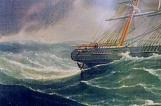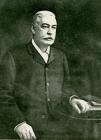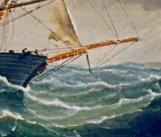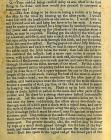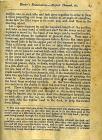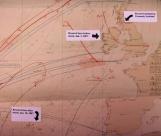15
The next morning was November 28th. The stern of the 'Research' was now sufficiently elevated to permit tackles being fastened to the ring-bolt on the back of the rudder. There was but one way to fasten them. A man must go down into the water and affix them. As the stern was projected far over the rudder, as the rudder itself was constantly battered to and fro by the fierce waves, the difficulties of such a task must be plain to the meanest capacity. And who was to do the job? It is in such emergencies that the first mate comes to the fore. On that bitter winter morning, Aaron Churchill stripped to the buff and went over the side 'in a bowline'.17
What Aaron Churchill sat in was a double bowline. One loop went round the thighs; the second went under one armpit, and over the opposite shoulder. Each loop draws against the other, and the knot is just over the heart, thus leaving both hands free. In such a harness of three-inch rope was the first mate of the 'Research' lowered over the side and into water with a temperature somewhere near freezing point. With one hand he held the tackle, and hooked block, or pulley, through which ropes ran. The hook must be slipped through the ring, when opportunity offered. This was a one hand job. Churchill needed his other hand to save himself from being battered to death against the side, or the overhang, of the vessel. On the deck above him, men paid out the line, or stood by to haul, and watched and lifted when the waves swept over the man below.19
The huge, heavy rudder was never at rest, but beating continually against the rudder-post with terrifying violence. Frozen, blinded, half-strangled, Churchill must watch for the favourable second when the ring-bolt was near enough for him to slip the hook of the tackle into it. That day Aaron Churchill was fighting not for his own life, but for the lives of all on board. After an hour and a half of incredible labour, he succeeded in hooking one tackle into the ring-bolt. He was hauled up on board insensible and laid out on the deck to recover. Half a pint of brandy was poured down his throat. Slowly he revived, slowly his strength returned; and then, - he went down over the other side of the ship with the second tackle.21
This time he was down for an hour and three-quarters by the clock, one hundred and five minutes of freezing, of strangulation, of desperate exertion, but, somehow or other, he managed to fasten the second tackle in the ring. One more typical first mate's job was done. The dangerous rudder was securely hobbled; the 'Research' was once more under control, and could be steered by the ancient device of pulling and hauling on the tackles. Aaron Churchill was dragged back to the deck more dead then alive.With help of the sails the vessel was kept on her course. But wind and wave are pitiless antagonists. The results so painfully obtained by Aaron Churchill at the risk of his life, hardly lasted twenty-four hours. On the 29th what was left of the rudder was torn from the pintles and swept away. Even a damaged rudder was better then none, and now the 'Research' had not even a fragment of hers left.
24
In the examinations for their certificates, would-be mates and masters were often asked how to rig a jury rudder. It was naturally considered a most important point.A 'jury' rudder was often made in two pieces, consisting of the stock, and the rudder itself. The latter was simply an oblong mass of heavy planking bolted together lengthwise and crosswise, as firm as the ship-carpenter's art could make it. The whole, heavy, clumsy contrivance with all its trailing ropes attached had to be hoisted out-board, lowered over the stern, and the stock drawn up through the 'casing.' Through the top and bottom of the rudder ran stout ropes, which were carried far forward on each side of the ship, and hauled taut. These would draw the rudder hard against the rudder-stock and hold both firmly against the rudder-post. To make the mechanics of the device plain to the landsman's comprehension, it might be said that this home-made rudder was tied to the stern by four strings. By means of two other 'strings' attached to the outer edge of the rudder by a looped rope called a 'bridle', and also carried far forward, the rudder was pulled this way or that, at the word of command.
To construct even such a rudder involved much hard labour with edge-tools, adjusting, calculating, measuring, shaping, sawing, hammering, boring, and joining, on the reeling deck of the labouring 'Research'. The deck-load of deals was not all started overboard; enough remained to supply materials for more then one or two jury rudders. For two days and two nights, the big timber-ship drove impotently before the storm, while officers and men toiled at the indispensable steering-gear, or snatched a mouthful of food, or an hour's sleep. On the morning of December 2nd, the jury rudder was completed. It was being lowered over the stern, when a wicked cross-sea caught it, and snapped the hawser like a thread. Away floated the rudder.
This sudden failure might have daunted any but a Nova Scotian ship-master; but George Churchill made a steering-oar. Churchill took a spare top-mast about sixty feet long, and to one end he bolted a huge square of the deck-load deals. This would be secured to the rail by strong lashings, which still would permit of its being moved to and fro. Other stout ropes would hold the inboard end in place. Like the jury rudder, this enormous steering oar would be moved to port or starboard by means of lines fastened to the 'spade' itself. Apparently it was ready for use the very next day, December 3rd; and hoisted into position. But it was a failure. By lightening the 'Research' aft, in order to get at the ring-bolt in the rudder, the stern was lifted high out of the water. It was therefore necessary to jettison part of the deck-load forward in order to restore her trim. So it was done.
On December 4th, the huge steering-oar was again hoisted over the stern; but it could not be sunk deep enough in the water to influence the way of the 'Research'; she was a big ship. It had to be taken on board and weighted. Next day, it was again hoisted out; the necessary leverage was gained, but the weight was too much for the spar. The handle of the 'spade' was fractured by the strain, about ten feet from the upper end. In spite of the break, these unconquerable sailormen got their vessel under control, and, by the aid of their damaged rudder, they sent the 'Research' storming along eastward, and ever eastward.
By December 9th the oar was spliced and repaired; but in attempting to hoist it out, the ropes gave way and let the huge concern down on the deck, where it had to be secured and lashed fast.
Nature is pitiless. The furious storm not only continued but grew more and more malignant. Moving hills of water broke over the helpless 'Research', smashing in the forward deck-house where the crew lived and wrecking the provision-locker. Soon they were on short allowance; and before the voyage ended their food ran out altogether.
26
The 'Research' began to leak. The oakum in the two big bow-ports worked out and the sea came in. A timber-laden vessel cannot sink, but she can become water-logged, a helpless, unnavigable hulk below the level of the waves. To avoid this calamity for days and weeks, day and night, spell and spell about, officers and men laboured at the wheel-pumps amidships, two at the handles and others tailing on to the ropes. Constant pumping kept the water down, but could not prevent it from coming in.Still in spite of wet, and cold, and exposure and the heart-breaking labour at the pumps, the men of the 'Research' built a third rudder, and, during a lull on the morning of December 14th, they got it 'shipped'. For a whole day, this clumsy contrivance functioned, and the vessel answered to her helm; but on the 15th the violent seas smashed the stock, and the rudder was useless.
On the twenty-first, a new rudder, Number Four, was begun. By January 2nd, 1867, it was got into its place, 'after much labour'. This rudder held, but it was not powerful enough to control the way of the vessel. 'It was necessary to put an additional rudder over the stern, like a steering-oar, worked with tackles from in-board.' It is difficult to keep tally of Churchill's inventions, but this makes Rudder Number Five. Navigating a leaking ship in hurricane weather, with two jury-rudders, the men pulling and hauling on two sets of tackles at the word of command must have presented difficulties, but Churchill, the indomitable, met them, overcame them, and kept his vessel on her course until January 5th, when 'the stock of the other was carried away and the rudder lost.' And now Rudder Number Four is out of the saga.
